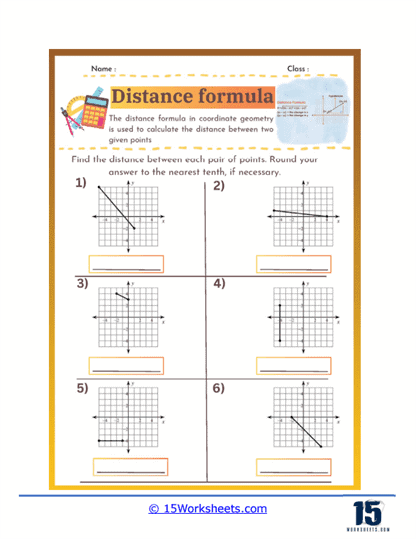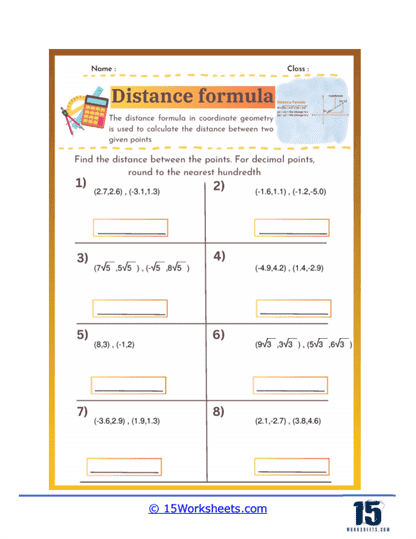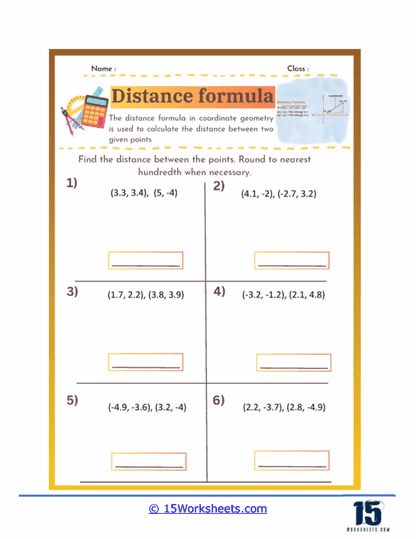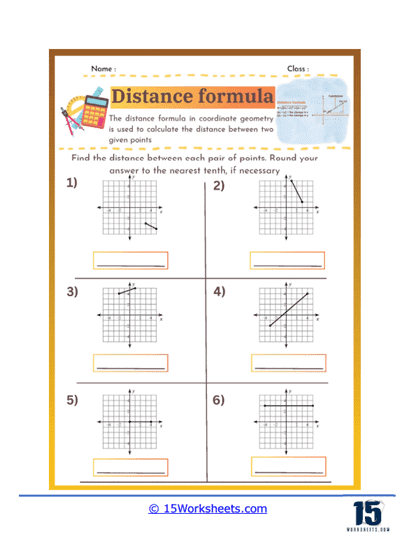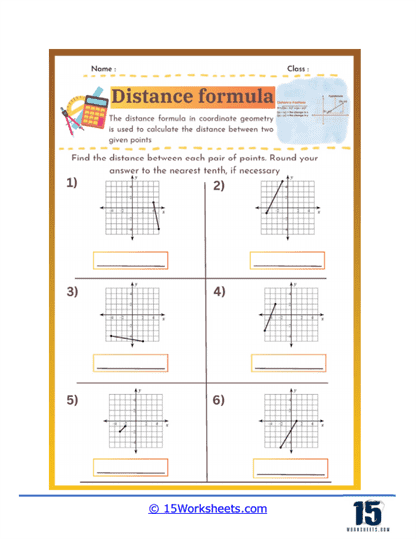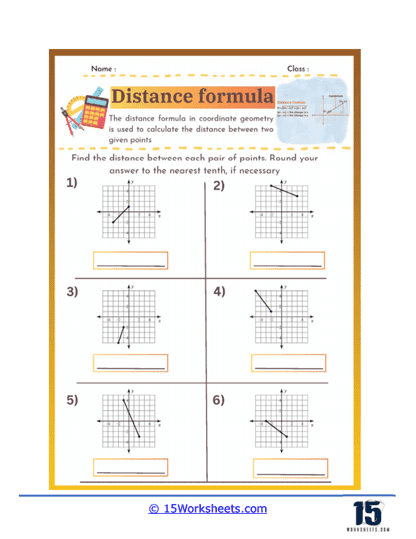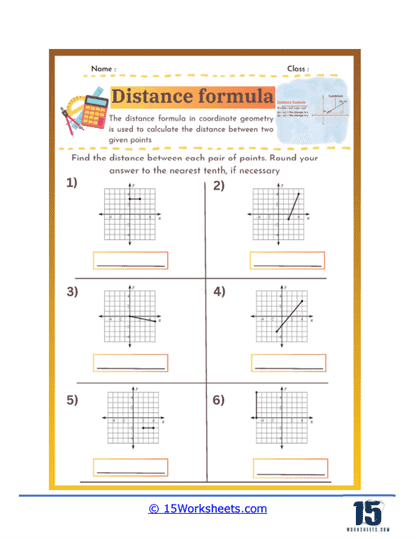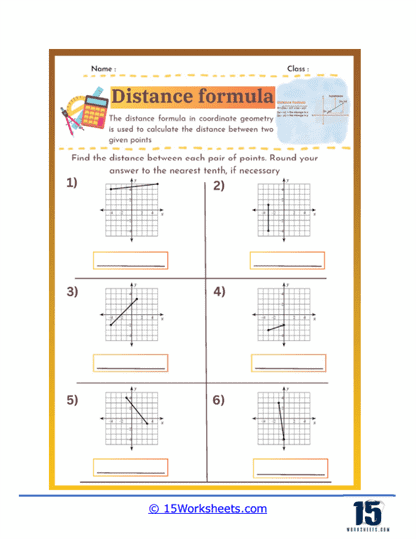Distance Formula Worksheets
About These 15 Worksheets
Distance formula worksheets will help students understand and apply the distance formula in coordinate geometry. This formula is essential for finding the distance between two points on a coordinate plane. Distance formula worksheets typically include a variety of problems that require students to practice calculating these distances using the distance formula. These worksheets often start with simple problems and gradually introduce more complex scenarios, helping students build their skills progressively.
What Is the Distance Formula?
The distance formula in mathematics is a fundamental tool used to determine the distance between two points in a coordinate plane. This formula is derived from the Pythagorean Theorem and provides a straightforward way to calculate the straight-line distance between two points, regardless of their position on the plane.
Math Skills Explored In These Worksheets
Distance formula worksheets explore several key math skills:
Coordinate Plane Navigation – Students learn to navigate the coordinate plane by identifying and plotting points. This foundational skill is crucial for understanding how to apply the distance formula.
Arithmetic Operations – These worksheets require students to perform basic arithmetic operations such as addition, subtraction, multiplication, and square root extraction. Mastery of these operations is necessary for accurately calculating distances.
Algebraic Manipulation – Students practice algebraic manipulation by working with the distance formula, which involves squaring differences, adding results, and taking square roots. This reinforces their algebra skills and prepares them for more advanced math topics.
Problem-Solving Skills – Students develop problem-solving skills by tackling various types of distance-related problems. These can range from straightforward calculations to more complex applications involving multiple steps and critical thinking.
Types of Exercises
Distance formula worksheets can include a wide range of exercises and practice problems designed to reinforce different aspects of the formula and its applications. Here are some common types:
Basic Distance Calculation – These exercises provide pairs of points and ask students to calculate the distance between them using the distance formula. This type of problem helps students become familiar with the formula and how to apply it.
Example – Find the distance between (2, 3) and (5, 7).
Graphical Representation – Problems that include graphs with plotted points require students to visually identify the coordinates before calculating the distance. This type of exercise helps students connect the abstract formula with concrete visual representations.
Example – Given a graph with points at (1, 4) and (4, 8), calculate the distance.
Complex Numbers – These problems involve points with radical or decimal coordinates, which add complexity to the calculations and require students to be precise in their arithmetic operations.
Word Problems – Real-world scenarios are presented where students must determine distances between points based on a given context. These problems help students see the practical applications of the distance formula.
Example – A drone flies from point A located at (2, 3) to point B at (6, 7). Calculate the distance traveled by the drone.
Rounding Practice – These exercises ask students to round their answers to a specified decimal place, reinforcing their skills in precision and rounding.
Example – Calculate the distance between (3.1, 4.2) and (5.6, 7.8), and round your answer to the nearest hundredth.
Distance in Real Life – Problems that incorporate real-life contexts such as navigation, mapping, and design, where students use the distance formula to solve practical problems.
Example – An architect designs a park with a fountain at (1, 2) and a statue at (4, 6). Calculate the distance between these two features to determine the length of the pathway connecting them.
Applications of the Distance Formula
1. Navigation and Mapping
In navigation and mapping, the distance formula is used to calculate the shortest distance between two geographical points. This is crucial for planning routes and estimating travel times. For example, GPS systems use this formula to provide drivers with the shortest or most efficient path from one location to another.
2. Architecture and Engineering
Architects and engineers use the distance formula to ensure precise measurements and spatial relationships in their designs. When creating blueprints and models, accurate distance calculations between points ensure that structures are built correctly and safely. This is particularly important when dealing with large-scale projects where small measurement errors can lead to significant problems.
Consider a scenario where a city planner needs to determine the distance between two landmarks in a city. The landmarks are located at coordinates (10, 20) and (30, 40). By applying the distance formula, the planner can calculate the straight-line distance between these two points, which is essential for planning infrastructure, determining travel routes, and making other logistical decisions.
3. Computer Graphics
In computer graphics, the distance formula is used to determine the distance between pixels, objects, or points in a digital space. This is essential for rendering images, animations, and simulations accurately. For instance, in 3D modeling and video game design, calculating distances between objects helps in collision detection, lighting effects, and perspective adjustments.
4. Astronomy
Astronomers use the distance formula to calculate the distance between celestial objects. By knowing the coordinates of stars, planets, or other astronomical bodies, scientists can determine how far apart they are. This information is vital for understanding the scale of the universe, the movement of objects in space, and for planning space missions.
5. Data Analysis
In data analysis, particularly in fields like machine learning and statistics, the distance formula is used to calculate the distance between data points. This is important for clustering algorithms, which group similar data points together, and for classification algorithms, which categorize data based on their distances from predefined categories.
Example Problem – Find the distance between the points (3, 4) and (7, 1).
Step-by-Step Solution
1. Identify the coordinates of the two points:
Point A – (3, 4)
Point B – (7, 1)
2. Label the coordinates:
a. 𝑥1 = 3
b. 𝑦1 = 4
c. 𝑥2 = 7
d. 𝑦2 = 1
3. Calculate the differences between the x-coordinates and y-coordinates:
a. Difference in x-coordinates – 𝑥2 – 𝑥1 = 7 – 3 = 4
b. Difference in y-coordinates – 𝑦2 – 𝑦1 = 1 – 4 = -3
4. Square the differences:
(𝑥2 – 𝑥1)2 = 42 = 16
(𝑦2 – 𝑦1)2 = (-3)2 = 9
5. Add the squares of the differences: 16 + 9 = 25
6. Take the square root of the sum: Square root of 25 = 5
Final Answer: The distance between the points (3, 4) and (7, 1) is 5 units.








